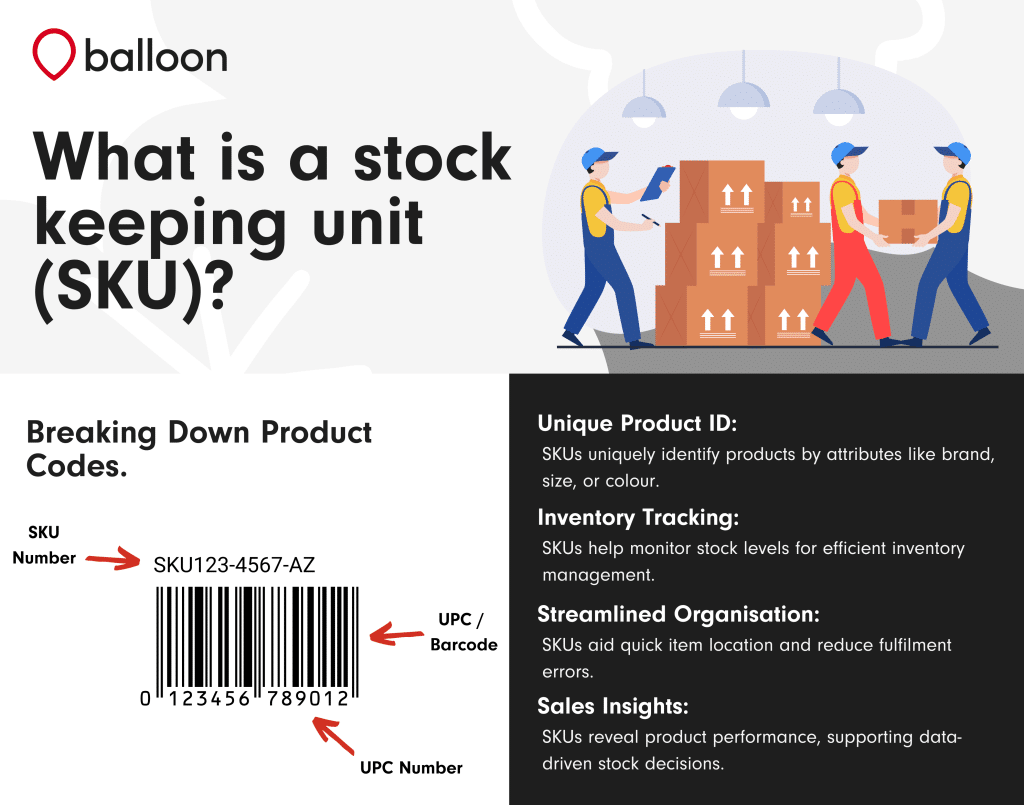SKU essentials: management, strategies and best practices.

A SKU system is the backbone of any efficient logistics and distribution system. SKUs are an effective tool for managing stock, especially in logistics operations that handle a large variety of products or those that require detailed tracking and reporting.
In this post, we help you to understand the complexities of SKU management, offering insights and strategies to help you optimise your system and employ SKU best practices that will transform how you handle your inventory.
What is a SKU number?

In logistics and distribution, a SKU is a unique identifier for each distinct product that a business holds in its warehouse.
SKU stands for ‘stock keeping unit’ and is an alphanumeric code typically made up of around eight to twelve characters, which serves as an essential tool for tracking and managing stock and the processes surrounding it.
Primarily, a SKU allows for precision when it comes to tracking and managing inventory, providing the warehouse with a clear understanding of what items are in stock, in transit or need replenishing. This helps maintain efficient stock levels and facilitates easy and rapid identification of products, streamlines order processing and enhances the accuracy of sales data and forecasting.
For faster identification, companies label their goods with a scannable SKU, typically using a barcode or QR code. By scanning the code, all manner of processes can be automated, such as amending stock levels, assigning goods to a different bin, marking items as picked, and more.
The anatomy of a SKU.

A SKU in logistics is not just a random string of characters. It is a carefully constructed code that holds significant information about the item it represents. Specific information can be represented by the code, or parts of it, such as the type of product, the manufacturer or brand, its colour, size or weight.
The construction of a SKU can vary significantly from one business to another and each company needs to tailor its SKUs to its specific products and its tracking and operational needs. However, the underlying principle is the same – to provide a clear, concise and quick reference to each unique item in a company’s inventory.
Basic SKU format.
Basic SKUs are straightforward and typically used by smaller businesses or for products that do not require detailed differentiation.
Basic SKUs are easy to create and simple to understand and manage. They are often short and consist of just a few elements, focusing mainly on the most essential aspects of the product. For example, a basic SKU for a shirt might include a simple product code and a size indicator, like ‘SHRT-M’ for a medium shirt.
Complex SKU format.
Complex SKUs are used by larger businesses or in cases where products have multiple attributes that need to be tracked. These SKUs are longer and include detailed information about each aspect of the product. For instance, a complex SKU for a laptop might include codes for the brand, model number, processor type, RAM, storage capacity and colour.
Here are some typical components of a complex SKU:
Product code -
Two or three letters might be used in the SKU to broadly categorise the item. For example, a retailer of stationery and writing instruments might use SKUs beginning ‘FPE’ for fountain pen, ‘PAP’ for paper, ‘ACC’ for accessories and so on.
Brand code -
Instead of a product code, a warehouse might use letters and numbers that denote each different brand or manufacturer. Or, for companies with large inventories, a brand identifier on top of the product code.
Attributes codes -
These often follow the product code and provide specific details about the product. Attributes might be size, colour, style or any other relevant characteristic. For instance, ‘BLU’ might indicate the colour blue, ‘EF’ could mean an extra fine nib, and ‘10’ could mean the number of items in a pack. One or more attributes can be used and their number will depend on the range of items sold.
Unique identifier -
The final part of a SKU is usually a unique number or set of characters that distinguishes each item within its category or attribute type. This part of the SKU ensures that no two products share the same SKU, even if they are similar.
For example, a clothing retailer selling several different black t-shirts would not be able to use TSH-BLK-38 as this would only identify a black t-shirt in size 38. Adding in random extra characters or those that also denote a style or a brand would be needed to help distinguish similar products.
Benefits of using SKUs.

SKUs have benefits that collectively contribute to the overall efficiency and profitability of a business.
Firstly, SKUs play a central role in streamlining your business processes. By assigning a unique identifier to each product, you can manage your stock more effectively. The time your staff spend in locating and tracking items is significantly reduced, which brings a more efficient workflow to your whole warehouse operation. This efficiency is particularly evident in retail environments, where SKUs make it easier for staff to quickly identify products.
Stock accuracy is another key advantage of using SKUs. Using SKUs minimises the likelihood of errors that can occur with manual tracking or when using less-specific methods of identifying your products. For example, SKUs help pickers select the correct items for orders, so reducing mistakes and improving customer satisfaction.
SKUs are also instrumental in improving your reporting and analytical capabilities. They make it easier to track sales trends, monitor stock levels and understand buyer behaviour. Using SKUs, you can generate detailed reports that offer insights into which products are performing well and which aren’t. Data like this is invaluable in making informed decisions about replenishment, promotional strategies or product development.
Using SKUs also helps you to integrate data across several different sales channels or platforms, which provides a comprehensive view of your business performance.
Challenges with SKUs.

As you expand your product lines, you will inevitably face the problem of SKU proliferation. This is the rapid increase in the number of SKUs you have as new products are added or variations are introduced. Managing an ever-growing stock can become complex, often leading to challenges in tracking, stocking and selling your products efficiently.
To meet the challenges of SKU proliferation, you can regularly rationalise your SKUs. This involves periodically reviewing and streamlining your SKU portfolio in order to eliminate underperforming or redundant products. Although by implementing clear guidelines for SKU creation in the first place, you can help prevent unnecessary complexity and duplication, which means you should need to undertake this rationalisation less often.
Software solutions, particularly warehouse management systems (WMS) or Inventory Management Systems, can also help you manage your SKUs more effectively. With sophisticated tools for stock tracking, order management and data analysis, a WMS helps you handle large volumes of SKUs systematically, ensuring accuracy and efficiency.
Practical SKU use and management.

In industries where stock management is a cornerstone of success, such as ecommerce and retail, the best practice use of SKUs is crucial.
Retailers and ecommerce providers typically handle a vast range of products, making a well-structured SKU system essential for maintaining accuracy and streamlining operations.
The sheer volume of items and the high level of sales transactions that these companies process necessitates a robust SKU system that ensures accuracy and efficiency in order fulfilment.
Effective SKU management enables these businesses to effectively manage a diverse inventory. With more precise tracking, rapid product retrieval and accurate order fulfilment, errors in shipping and handling are minimised. This provides customers with a reliable service, which ensures high levels of customer satisfaction and loyalty.
Frequently Asked Questions.
SKU Defined: A Stock Keeping Unit (SKU) is a unique identifier for each product or service that can be purchased. It allows businesses to track products and sales.
Barcode: A barcode, including a UPC code, is a machine-readable representation of data designed for external operations. While SKUs facilitate internal tracking, barcodes, such as UPCs, are essential for point-of-sale transactions and inventory management.
A SKU number, or stock keeping unit number, is a unique identifier assigned to a product by a retailer or manufacturer. It helps track inventory and distinguish between similar products.
Creating SKUs: Establish a consistent format, typically comprising alphanumeric characters. Include identifiers like brand, product type, size, and colour.
Assigning SKUs: Apply the SKU to each unique product variant. For example, a blue, medium-sized T-shirt might have the SKU “BLU-MED-TSHIRT.”
Best Practices:
- Keep SKU codes simple and consistent.
- Avoid using special characters.
- Regularly review and update your SKUs to reflect new products or discontinued items.
- Train your staff on the importance and usage of SKUs for efficient inventory management.